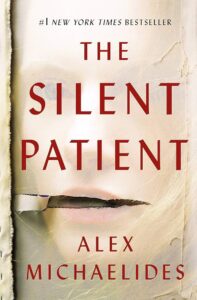The Silent Patient by Alex Michaelides

Plot: ⭐️ ⭐️ ⭐️ ⭐️/5
Character Development: ⭐️ ⭐️ ⭐️/5
Flow: ⭐️ ⭐️ ⭐️ ⭐️/5
Theme: ⭐️ ⭐️ ⭐️ ⭐️ /5
Writing Style: ⭐️ ⭐️ ⭐️ ⭐️/5
Emotional Resonance: ⭐️ ⭐️ ⭐️ /5
My first thought is to say that I thought this book would be scarier than it was. I knew about it for a long time and back when I was a bookseller at Barnes and Noble I would recommend it to people who were looking for a thriller. It was a fantastic story but now I feel like a bit of a fraud saying that it would scare people. StoryGraph classifies it as a fiction, mystery thriller which I guess does make sense, but I would put more emphasis on the mystery than the thriller.
The first thing I would tell someone when recommending the book: it’s not as scary as it’s made to appear. The cover is quite ominous, and the description gives that creepy feeling when you don’t know what’s going to happen but you can’t look away because you have to know what will happen. Everything that the story is trying to do, I would argue, it does quite well, and I was engaged until the very last page…but not really scared.
However, my best friend did actually get scared and toss the book across her bed at one point. So I guess it is possible to find this book to be more of a thriller and actually scary, depending on if your imagination is working against you that day.
The story begins with the perspective of Alice, though she is the patient who becomes silent, by way of her diary from before she goes mute. We learn that she is an artist, a painter, and that she’s quite accomplished in the field. When she starts the diary, we learn that she is having a hard time with her work; she has deadlines with the art gallery she is struggling to meet before an exhibit and her husband, Gabriel, is hoping that expressing her feelings in the diary will help her release any negativity and allow her to get back to her work.
Alice has a history of mental illness and understands how her episodes can rule her life and make the lives of those she loves harder. She agrees to the diary because she loves her husband dearly and will do what he suggests because she knows he does it out of his deep love for her. If there is one thing that Alice is certain of, it’s her husband’s devotion to her. Yet, we also know from the start that she kills him.
We then flash to the present, to a new perspective; Dr. Theo Faber is a psychotherapist with a deeply troubled childhood who is passionate about the work of therapy, knowing personally how it can improve someone’s life. He himself went through a great deal of therapy after his parents divorce and it’s what led him down the path to become a therapist. Theo begins the story being inextricably drawn to the girl in the news who shot her husband and hasn’t spoken a word since. He is certain that he is the one who can get her to speak after years of complete silence.
So Theo gets a job at the facility Alice now lives at, having remained silent for years. The place is on the verge of shutting down and Theo is quite skilled in his career so it doesn’t make sense to anyone that he would take the job. He is desperate to get Alice to like him, to trust him, and, ideally, to talk to him.
The story flashes between Theo’s wife at home, where he finds out that his wife has been unfaithful; Alice’s life before the murder; and the two of them interacting in the facility. The timeline of the story is the trickiest piece to nail down and as the story goes on it becomes clear that the fragments we’ve been learning down line up cleanly in their timing as we would have believed, having read them as though they are chronological.
The plot twist of the story is quite singular. Having known so many stories throughout the years I would like to argue that I can pick up a basic plot line pretty easily. No doubt, there were pieces of the story that I saw coming a thousand miles away but that doesn’t mean they were bad. Even if I thought I knew what was going to happen, even if I was occasionally right, the puzzle was clearly out of my hands. Not a puzzle I would have solved on my own.
That’s what I think makes this a great story. Murder mysteries are always fun, even when you know that it was the maid, or the wife, or the son. I appreciate that the mystery of this story wasn’t who killed him: we know that Alice did it from the very beginning. The real mystery is why she did it?
It reminds me of Tartt’s The Secret History in that way. We knew that Bunny dies from the prologue, but why and how and what happened to his friends along the way—those are the nitty gritty details of intrigue that take a story from good and fun, to exciting and original.
Turning abstract and philosophical, this story does a great job of making you question who is good, who is bad, and why you think that? Every character is not what they seem. Maybe none of them are really good? That would certainly be more realistic. People are complicated, we make mistakes, we don’t always think things through and then dealing with the consequences becomes the hardest part of the whole ordeal.
There is a lot to consider in this book. I’d love to discuss it in a book club.

